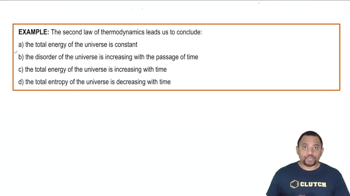Here are the essential concepts you must grasp in order to answer the question correctly.
Entropy (ΔS)
Entropy is a measure of the disorder or randomness in a system. In thermodynamics, a positive change in entropy (ΔS > 0) indicates an increase in disorder, while a negative change (ΔS < 0) signifies a decrease in disorder. Understanding how entropy changes during a chemical reaction is crucial for predicting the spontaneity of the process.
Recommended video:
Entropy in Thermodynamics
Second Law of Thermodynamics
The Second Law of Thermodynamics states that the total entropy of an isolated system can never decrease over time. It implies that natural processes tend to move towards a state of maximum disorder or entropy. This law is fundamental in determining the sign of the change in the universe's entropy (ΔS_univ) during a reaction, as it combines the entropy changes of both the system and its surroundings.
Recommended video:
Second Law of Thermodynamics Example
Gibbs Free Energy (ΔG)
Gibbs Free Energy is a thermodynamic potential that helps predict the direction of chemical reactions and phase changes. It is defined as ΔG = ΔH - TΔS, where ΔH is the change in enthalpy, T is the temperature in Kelvin, and ΔS is the change in entropy. A negative ΔG indicates a spontaneous process, which is closely related to the signs of ΔS and ΔH, making it essential for analyzing the reaction's feasibility.
Recommended video:
Gibbs Free Energy of Reactions





